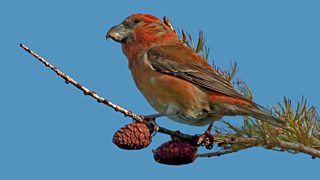When you want to unscrew a screw you need the right screwdriver, in the right size. When it’s a nut you want to change you reach for a spanner, again in the right size. The right tool equals a job well done.
So when you’re a bird that specialises in eating the seeds locked into hard green conifer cones, you need the right tool for getting into them. You need a bill that’s designed to prise open tightly closed cones. Meet the crossbill.

Parrot crossbill at Holt Country Park in Norfolk by Norfolk Wildlife Trust
Crossbills are the only birds in the world with (you’d never guess it) crossed-over bills. The muscles a bird uses to bite down are stronger than those it uses to open its bill - something the crafty crossbill puts to good use.
This bird slightly opens its bill and places the tips of its upper and lower mandibles under the scale of an unripe cone. As it closes its bill, the tips cross back into place, forcing the scale away from the cone and revealing the fatty seed beneath. Lunch!
In general we have two species of crossbill in the UK: the crossbill (now usually known as the common crossbill, though it’s far from common if you live away from conifer forests) and the Scottish crossbill which lives exclusively in the Caledonian pine-forests of the Highlands.
The Scottish crossbill, if indeed it is a valid species - scientists are far from sure - is the only bird wholly restricted to the UK. A Scottish endemic. The common crossbill lives throughout the UK wherever there are large plantations of conifers.
Crossbills of all species are highly dependent on the seeds of conifers. As they possess the unusual behaviour of feeding their young on conifer seeds, crossbills can start breeding in the middle of winter as long as plenty of food is available.
After breeding, depending on the availability of seeds, common crossbills across Europe sometimes irrupt (volcanos erupt, crossbills irrupt), meaning they spread out across the continent, sometimes in huge numbers, in search of food.
In the winter of 2013-14 many crossbills have reached the UK and, exceptionally, with them this time are plenty of Europe’s two other crossbill species. The two-barred crossbill – ornithologists being fairly humourless, literal creatures – has two white bars on its wings. It is our eastern-most species, nesting largely in Russia and, as it specialises in feeding on the delicate cones of larch, it has a much smaller bill than the others - think: fine tweezers for a fiddly job. The two-barred crossbill is generally a very rare bird in the UK but this winter there have been many, including birds in Shropshire and Norfolk, and a record-breaking flock of more than two dozen in the Forest of Dean.
At the opposite end of the crossbill beak-bulk spectrum is the parrot crossbill, the bolt-cutter of the group. Normally a bird of northern Scandinavia and Russia, the species has recently established a small population in Scotland.
It is by far the heaviest-billed of the crossbills, with a correspondingly strong head and thick neck, and it has the strength to open the toughest cones. This winter several flocks of these rare cone-cleavers have been seen, principally in Nottinghamshire and East Anglia.
Though all crossbills have loud, insistent flight-calls and adult males are intensely red (females being a tasteful mossy green), they are astonishingly difficult to see when they settle into pines and spruces to feed.
As you wait beneath a stand of trees, very often the only sign of the presence of a posse of these birds is the falling of debris – even whole cones – from the canopy as they demolish the cones for their seeds.
As hard as they might be to spot, there will never be a better winter for watching crossbills in the UK, with all four European species present here in flocks. So on a bright clear day this winter go to the pinewoods and listen for the exuberant chip of common crossbills passing overhead. You never know which northern rarities might be with them.
For more wildlife information, please visit the .
